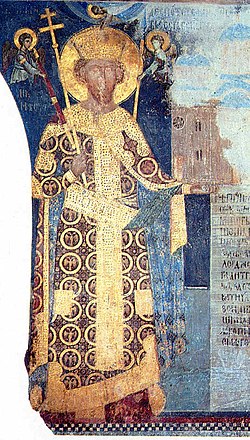Top Qs
Timeline
Chat
Perspective
October 9 (Eastern Orthodox liturgics)
From Wikipedia, the free encyclopedia
Remove ads
October 8 - Eastern Orthodox liturgical calendar - October 10

All fixed commemorations below celebrated on October 22 by Eastern Orthodox Churches on the Old Calendar.[note 1]
For October 9th, Orthodox Churches on the Old Calendar commemorate the Saints listed on September 26.
Saints
- Righteous Forefather Abraham and his nephew righteous Lot (c. 2000 B.C.)[1][2][3][4][5][note 2][note 3]
- Holy Apostle James, son of Alphaeus (1st century)[1][3][7][8]
- Saint Demetrius, Bishop of Alexandria (231)[1][9]
- Saint Publia the Confessor, Deaconess, of Antioch (361-363)[1][3][10][11][note 4]
- Martyrs Juventinus and Maximinus, soldiers, at Antioch (361-363)[1][9][12][13][14] (see also: September 5, October 12)
- Venerables Andronicus and his wife St. Athanasia, of Egypt (6th century)[1][3][15][16][17][note 5] (see also: March 2 )
- Saint Peter of Galatia (9th century)[1][3][18][19]
Remove ads
Pre-Schism Western saints
- Hieromartyr Dionysius (Denis, Dennis, Denys), Bishop of Paris,[1][9][20] with his companions Rusticus and Eleutherius (c. 258)[21][22][note 6]
- Saint Domninus of Fidenza (Donnino), martyr (304)[21][note 7][note 8]
- Saint Gislenus (Ghislain, Guislain), a confessor and anchorite in Belgium (680)[21][23][note 9][note 10]
- Saints Lambert and Valerius (Bellère, Beriher), disciples of St Gislenus in Belgium and the north of France (c. 680)[21]
- Saint Geminus, A monk at San Paterniano de Fano in Umbria, Italy (c. 815)[21][note 11]
- Saint Savin (Sabinus), venerated as one of the Apostles of the Lavedan, in the Pyrenees, France (c. 820)[21][24]
- Saint Deusdedit, a monk at Montecassino in Italy, chosen abbot about the year 830 (836)[21][note 12][note 13]
- Saint Gunther of Bohemia, a Bohemian hermit (1045)[21][note 14]
Remove ads
Post-Schism Orthodox saints
- Blessed Stefan Lazarević, King of Serbia (1427)[1][9]
- Saint Stephen the Blind, King of Serbia (1468)[1][9][25]
New Martys and Confessors
Other commemorations
- Icon of the Most Holy Theotokos "Korsun" (Cherson) (988)[1][9][12][13][26][note 15]
- Icon of the Most Holy Theotokos "Assuage My Sorrow" (12th century)[1][9][27]
- Glorification (1989) of New Hiero-confessor Tikhon (Bellavin), Patriarch of Moscow and all Russia (1925)[28][29] (see also: September 26 )
- Uncovering of the relics (1997) of New Hiero-confessor Sebastian (Fomin), Archimandrite, of Optina and Karaganda (1966)[1][12][13][note 16]
- Uncovering of the relics (2007) of St. Job (Kundrya), Archimandrite, of Malaya Ugolka, Carpatho-Russia (1985)[30][31] (see also: July 15 )
Remove ads
Icon gallery
- Patriarch Abraham.
- Saint Publia the Confessor, Deaconess, of Antioch.
- Martyrs Juventinus and Maximinus, soldiers, at Antioch.
- Martyr Maximinus (Maxym), soldier.
- Hieromartyr Dionysius, Bishop of Paris.
- St. Gunther of Bohemia, tombstone effigy.
- Blessed Stefan Lazarević, King of Serbia.
- Icon of the Most Holy Theotokos "Korsun" (Cherson).
- Reliquary containing the relics of New Hiero-confessor Sebastian (Fomin).
Remove ads
Notes
- The notation Old Style or (OS) is sometimes used to indicate a date in the Julian Calendar (which is used by churches on the "Old Calendar").
The notation New Style or (NS), indicates a date in the Revised Julian calendar (which is used by churches on the "New Calendar"). - "At Antioch, St. Publia, abbess, who, whilst Julian the Apostate was passing by, sang with her religious these words of David:
- "The idols of the Gentiles are silver and gold;" and: "Let them that make them, become like unto them."
- According to St Gregory of Tours, Denis, or Dionysius, was born in Italy and sent with five other bishops to Gaul: he became the first Bishop of Paris. He and his two companions were beheaded under Decius and the monastery of St Denis was built over their tomb. (Note, the Roman Martyrology confounds Dionysius of Paris with Dionysius the Areopagite).
- Born in Parma in Italy, while fleeing his persecutors, he was overtaken and beheaded on the Via Claudia or Aemilia. This was a few miles outside Parma at a place now called Borgo San Donnino after him, where his relics are venerated.
- A hermit who lived in the forest in Hainault in Belgium where several disciples gathered around him. He built the monastery of Sts Peter and Paul, now Saint-Ghislain near Mons, where he was abbot for thirty years.
- He is the patron-saint of San Gemini.
- He was noted for his almsgiving. To extort money from him, a tyrant ill-treated and imprisoned him. He died in prison of hunger and misery and was venerated as a martyr.
- A cousin of St Stephen of Hungary. He began life full of worldly ambition, but was brought to better ways by St Godehard of Hildesheim and became a monk at Niederaltaich in Bavaria. His ambitious nature asserted itself once more and he became Abbot of Göllingen but proved a failure. Made wise by experience, he went to live as a hermit for twenty-eight years in the mountains of Bakory in Hungary.
- See: (in Russian) Корсунская икона Божией Матери. Википедии. (Russian Wikipedia).
- See: (in Russian) Севастиан (Фомин). Википедии. (Russian Wikipedia).
Remove ads
References
Sources
Wikiwand - on
Seamless Wikipedia browsing. On steroids.
Remove ads










